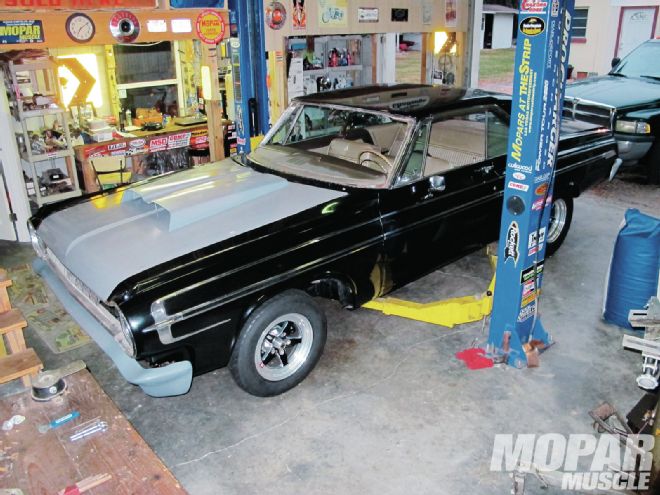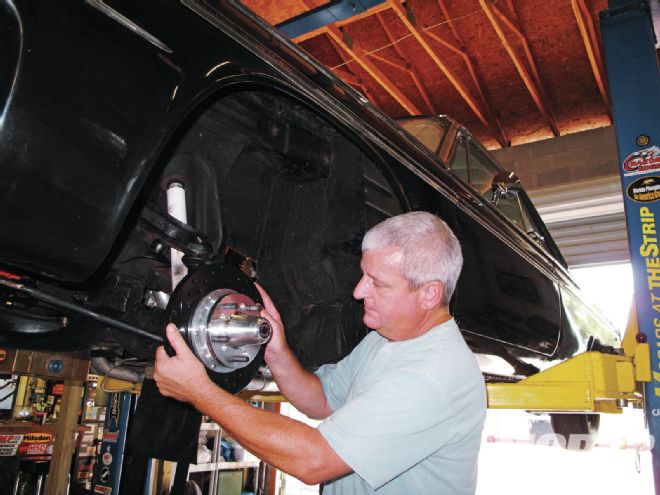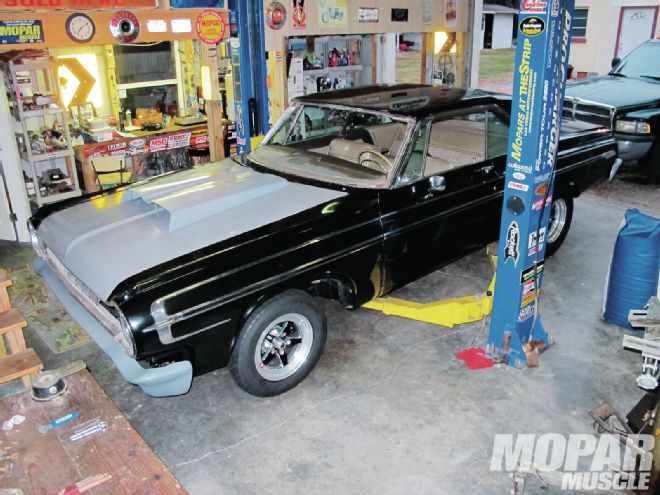
Last month we introduced our latest project, a ’64 Dodge Polara hardtop, which we’ll be transforming into a street/strip car that will ultimately run in the Nostalgia Super Stock drag racing class. Since the Nostalgia Super Stock class runs on an index format, it allows us to build the car much as you would, making our upgrades one at a time to make the car quicker as we go. And while we’re eager to get this car running and driving, and to take it to the track, there are some basic upgrades that need to be accomplished before we even think about driving on the streets or the strip. Equipped with 10-inch drum brakes from the factory, our ’64 B-Body is desperately in need of a brake upgrade in the interest of safety.
Our factory drum brakes are really ancient in terms of braking technology. Other than pressing the friction compound to the inside of the drum rather than the outside of the wheel, drum brakes use the same theoretical stopping method as the hand brake on a wagon pulled by a horse. Drum brakes are also prone to hold heat, which leads to brake fade, and compared to modern disc brake systems, the drum brakes and associated components are heavy and don’t stop the car nearly as well. Since we’re building our Dodge to see both street and track duty, we needed a good set of disc brakes to replace the factory brakes on our car. We also needed a modern master cylinder to replace the “pump and pray” single cylinder our Dodge was originally equipped with. A quick check of Wilwood’s website, allowed us to quickly make a decision as to which brake components would be best for our application.
 Once we get our 1964 Dodge to the track, we want to be sure it will stop, so one of the first upgrades we’ll make is installing front and rear disc brakes from Wilwood.
Once we get our 1964 Dodge to the track, we want to be sure it will stop, so one of the first upgrades we’ll make is installing front and rear disc brakes from Wilwood.
The brakes of a car are generally thought of as a safety feature, but the right brakes can also make a car quicker by lightening the rotating and un-sprung weight of the vehicle. Back in the fifties, sixties, and into the seventies, drag car builders would install the smallest nine-inch drum brakes they could on the racecar they were building, to reduce weight and friction. Early factory disc brakes utilized heavy rotors and cast-iron calipers, and the friction pads would constantly rub on the rotors even when the brake pedal was released. This friction actually slowed the car down compared to drum brakes which could be adjusted so the brake shoes didn’t contact the drum unless the pedal was pressed.
Modern disc brakes like the Wilwood brakes we’re installing, are light years ahead of drum brakes in terms of technology, and offer many benefits when compared to factory disc brake systems as well. Wilwood offers brakes for a variety of applications including road racing, which requires large diameter rotors and huge calipers, to super lightweight drag racing applications where repeated stopping isn’t an issue. Wilwood brakes are available for classic Mopar—like our ’64 Dodge, all the way to the most modern LX platform late-model Chargers, Challengers, 300s, and Magnums. Since our car will see limited street use initially, and due to its estimated 3,500 pound race weight, we decided against the lightest drag brakes Wilwood offers, instead choosing Wilwood’s Dynalite Pro Series front brake kit and their Dynapro rear disc brake kit for our Polara. We also decided to install a Wilwood aluminum tandem master cylinder, which features one inch pistons and separate reservoirs for the front and rear brakes, making it much safer than the factory single master cylinder.
Installing the Dynalite Pro Series front brakes on our Dodge is straightforward, and first requires removing the stock brakes from the car. The hub and rotor are separate pieces that must be assembled before installation, and fit directly onto the factory drum brake spindle. The caliper mount also bolts directly to the factory spindle, and the brake kit comes with all new wheel bearings and performance brake pads. The PN 140-11020 front brake kit we utilized features 11-inch vented rotors, and we chose the option of having the rotors drilled and slotted to further reduce weight and improve heat dissipation. The calipers provided with our front brake kit are lightweight aluminum four-piston units, powder coated black. Compared to the factory drum brakes, the Wilwood Dynalite disc brakes shaved nearly 35 pounds from the front of our B-Body.
Knowing that the rear brakes only provide about 30 percent of the car’s braking, we decided we could utilize a somewhat lighter set of rear disc brakes by opting for non-vented rotors. The Wilwood Dynapro dynamic mount drag race rear axle kit will offer dramatically better braking than our car’s factory drum brakes, while also lightening the car significantly. In fact, each of the four drum brake assemblies we removed from our Dodge weighed right at 30 pounds, while the entire Wilwood rear disc brake kit for both sides weighs less than 25 pounds, which is less than a single drum brake assembly. The Dynapro rear brake kits are available in a variety of offsets, including the 21⁄2-inch offset required for our application. The rotors with our kit are 11.44 inch diameter, and are drilled for lightening. These rear rotors are also separate from the hubs, and must be assembled prior to being placed on the axle. The rear calipers are made from billet aluminum, and utilize aluminum mounting brackets that bolt directly to the axle ends of our 8 ¾ differential.
All told it took the better part of a day to install our brake kits, then another day to measure, buy from the local parts store, and install all new steel brake lines for our car. We also installed Wilwood’s billet aluminum tandem master cylinder, which required the fabrication of an adapter plate since our car was equipped with power brakes from the factory. We used ¼-inch aluminum plate for our adapter, drilling holes to mount the plate using the factory provisions for the brake booster. We also installed one of Wilwood’s adjustable proportioning valves in the line to the rear brakes, mounting it in a position accessible from the driver’s seat for easy adjustment. With the brakes installed, we filled the system with Wilwood high temp 570 brake fluid, bled the system, and checked for leaks.
Once we complete our Dodge project car we’ll test the brakes and seat the pads. We’re sure our car will stop in substantially shorter distances with the Wilwood brakes installed, making it much safer on the street or at the track. Our Dodge is lighter as well, and much of the weight savings is rotating weight, which makes a substantial difference in acceleration performance. Be sure to follow future issues of Mopar Muscle as we continue building our Nostalgia Super Stock Dodge, and check out www.moparmuscle.com for additional photos of this car.
Price Tag
Part
PN
Cost
Wilwood Dynalite Pro front disc brake kit
140-11020
$787.49
Wilwood Dynapro rear disc brake kit
140-12546
$694.99
Wilwood aluminum tandem master cylinder
260-8555-BK
$239.95
Wilwood adjustable proportioning valve
260-8419
$41.94
Wilwood flexible brake lines
220-8307
$59.95
Metal brake lines from local parts store
$115.00
 13] Since our car isn’t completed, we can’t provide any braking distance numbers yet, but once we get our car to the track we’ll certainly provide this information for you. Compared to the factory ten-inch drum brakes, we’re confident the Wilwood discs will dramatically decrease the braking distance of our Dodge.
13] Since our car isn’t completed, we can’t provide any braking distance numbers yet, but once we get our car to the track we’ll certainly provide this information for you. Compared to the factory ten-inch drum brakes, we’re confident the Wilwood discs will dramatically decrease the braking distance of our Dodge.